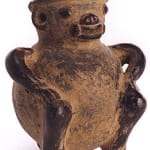Guanacaste-Nicoya Sculpture of a Monkey, 300 BCE - 300 CE
Terracotta
3.375 x 4.5
PF.3149
This pendant has been cleverly designed in the shape of a human figure arrayed as a monkey. The relative degree of a 'human' or 'monkey' seen in this delightful work...
This pendant has been cleverly designed in the shape of a human figure arrayed as a monkey. The relative degree of a "human" or "monkey" seen in this delightful work of art is due to one's own perception. Some may see it as an obviously masked human, while others may see it as a much more ambiguous phenomenon which has monkey and human characteristics. This pendant probably depicts a shaman or chieftain-shaman with a high political and religious status. The monkey may have been chosen as a symbol of strength and nobility among animals. It is also reclusive in nature, a dweller in the high forest canopy and a striking image when glimpsed with its human-like arms, legs and face. The monkey is the closest resembling animal to ourselves, and it is possible that it was viewed as an emissary, the all-knowing "eyes and ears" of the shaman-monkey. Pendants are found in high-status tombs. This suggests use in a ritual context. It is a charming work of art with its decorative cap and hands on its knee. There is a friendly smile and an expression of kindness on its face. This monkey is very content and has a good-natured disposition. This special pendant continues to pass on its friendliness from ancient hands to the present.



